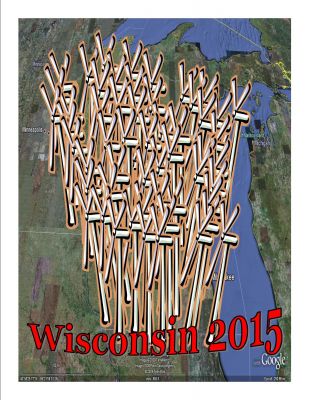Entries in wind transmission (1)
10/1/10 Save the date! Senate hearing on Wind Siting Rules set for October 13th AND Coming to your county soon? How many 400-500 foot tall turbines will it take to satisfy wind developers in Wisconsin? AND How does eminent domain fit into the wind development picture?
Senate
PUBLIC HEARING
Committee on Commerce, Utilities, Energy, and RailThe Senate Committee on Utilities, Energy and Rail will hold a public hearing on Wednesday, October 13, 2010 11:00 AM, 411 South at the State Capitol in Madison relating to Clearinghouse Rule 10-057 siting of wind energy systems.
Senator Jeffry Plale, Chair
CLICK HERE TO DOWNLOAD CLEARING HOUSE RULE 10-057
Correction: The Butler Ridge wind project is in Dodge County, south of the Fond du Lac County line.

Midwest must almost double wind power production to meet 2025 goal
SOURCE: Wisconsin State Journal:
By JUDY NEWMAN
September 30, 2010
Wisconsin and four other Upper Midwest states will need 15,000 megawatts of wind energy by 2025 — or about 8,600 megawatts more than already available — to fulfill their renewable energy goals, a study says.
In addition, it will cost an estimated $3 billion to build the transmission lines that will hook the wind power into the electric transmission grid.
The 15-page report, issued Thursday by a committee representing Wisconsin, Iowa, Minnesota and North and South Dakota, identifies 20 renewable energy zones within the five states, windy enough to serve as a power resource.
It also suggests six transmission corridors “that would efficiently move energy from these wind zones to customers, and serve as a backbone for a variety of future development needs in the region, and potentially further east.”
Two of the possible corridors for the high-voltage transmission lines extend into Wisconsin, including one that would run from Iowa to Madison.
The committee, called the Upper Midwest Transmission Development Initiative, will continue to meet to talk about potential cost allocation and other factors. No specific routes for the new transmission lines have been proposed yet.
However, at least three transmission companies have outlined possible projects with similar goals.
WIND TURBINES IN THE NEWS:
WYOMING WIND TASK FORCE FAVORS EMINENT DOMAIN LIMITS
Source: Bloomberg Business Week
September 30, 2010
By Bob Moen
"If we can restrict eminent domain in any way I think our landowners support that because we believe these issues should be addressed through private negotiations and agreement, not through holding a gun to somebody's head and threatening eminent domain, which basically forces the landowner to take whatever the condemner is offering because they have the greater power,"
Private companies that want to string small power lines from wind turbines to the main power grid wouldn't be able to seize land from Wyoming landowners under a recommendation made by a task force Thursday.
The Wind Energy Task Force voted 5-4 to deny the power of eminent domain to private companies building so-called collector lines for wind projects in the state. Eminent domain is the forced acquisition of private property for public use and has been used to build railroads, pipelines and other projects.
At the same time, the panel recommends that regulated public utilities retain the power of eminent domain. Public utilities are subjected to more scrutiny from state Public Service Commission regulations and oversight.
Task force chairman Rep. Kermit Brown, R-Laramie, said the panel's eminent domain recommendation seeks fairness for landowners whose land is needed only for small collector lines.
"All he gets is one lump sum payment for the fair market value of what little property they need and he never sees another dime," Brown said.
Landowners with the wind turbines on their land pocket monthly checks from the wind producer, Brown said.
The task force's recommendations go the Legislature, which would have to approve any change in state eminent domain law.
Wyoming imposed a moratorium on the use of eminent domain for collector lines that went into effect in March and will last through June 30, 2011. It's meant to buy some time for Wyoming citizens and policymakers to examine the issue.
The Legislature last made changes to the state's eminent domain law in 2007 mainly because of complaints from landowners who felt run over by booming oil and gas development. The process proved contentious.
Brown still refers to the 2007 debate as the "eminent domain wars."
"They're just tough, tough issues every time they come up," he said.
Jill Morrison, an organizer with the Powder River Basin Resource Council, which advocates for private landowners, applauded the panel's decision.
"If we can restrict eminent domain in any way I think our landowners support that because we believe these issues should be addressed through private negotiations and agreement, not through holding a gun to somebody's head and threatening eminent domain, which basically forces the landowner to take whatever the condemner is offering because they have the greater power," Morrison said.
Cheryl Riley, executive director of the Wyoming Power Producers Coalition, declined immediate comment on the task force's action until she can study its recommendation.
Brown said he couldn't say how the task force's recommendations might affect the growing wind industry in Wyoming.
The dozens of wind farms that have been built or are being proposed in the state so far have hugged the main power transmission lines that cross the state. Building wind farms farther away from the grid will mean erecting many more of the collector lines.
Wyoming is one of the most reliably windy inland areas of the United States, and its wind energy potential has attracted wide interest in recent years.